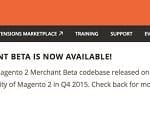Magento 2 is a topic of conversation that has been circulating the Magento community for a while now. Magento fans are ready for the new technology and even appear willing to accept an entirely new version of their beloved eCommerce platform. However with no official word from eBay (the owners of Magento), many are left wondering when the new version will be available.
Whilst we unfortunately don’t have any insider secrets about Magento 2, we are more than happy to share what we’ve learn so far from Magento events, materials and other resources. Please keep in mind that none of this information has been confirmed by eBay.
Magento 2 release data predictions
Magento 2 has been a long time in the making. It was originally announced in 2010; however the project was put on hold in 2011. Four years on and it’s still not seen the light of day, however as of recently, there’s been some solid movement on the project.
It’s expected to go from being a developer beta in the first quarter of the year to a merchant beta by the third quarter of the year. This means that your team or the agency you work with will be able to start playing around with it and seeing what it has to offer. By the fourth quarter of the year, Magento 2 is expected to be available to use fully.
What to expect from Magento 2
The new version of Magento is expected to offer a significant upgrade of its predecessor. With an updated technology stack, streamlined customisation process and simplified external integrations, it should make the platform more efficient and user-friendly than ever before.
Magento 2 users will also notice improvements in the software’s scalability and performance. Its bulkiness has always been an issue for some users; however the new version of Magento is expected to be quicker; using Require.js to improve page loading times.
We are expecting to see improvements to the Magento installation procedure, as well as an easier upgrade process. The platform should come with better quality testing resources and documentation, making installing, configuring and using Magento a far more straightforward process.
Responsive design
With Google’s new mobile search algorithm launching in a couple of weeks time, you’ll be pleased to hear that Magento 2 will be fully responsive out of the box. This is a very important development as it means that all Magento websites will be able to benefit from elevated mobile search rankings on Google.
Magento 2 features and architecture
Magento 2 will use PHP 5.4 and 5.5, HTML 5, CSS3 and moves from prototype.js to jQuery. The new release will also support modern coding standards. Require.js will be used to increase page loading times – something Magento users have been wanting for a while now.
Performance and scalability
Magento 2 will offer full page cache out of the box, as well as support for Varnish and Redis. Refactored indexers will work in the background to avoid blocking processes.
The new version of the platform will also benefit from improved indexers. The new indexers will cover the same functionality as previous enterprise versions, however they have been revised to delivery enhanced query performance and more efficient updates.
Magento 2 will enable the creation of multiple admin users. Core improvements have been made to the admin site to allow more admin users to update products, without data conflicts.
Upgrading to Magento 2
Although Magento 2 is not publically available yet, once it is, we will be providing a full upgrade service. Our experienced team of Magento developers will be able to take you through the upgrade process from installation and configuration to testing and troubleshooting.
We’ll be delivering Magento 2 news updates as they come, so be sure to check back soon! In the meantime if you need Magento support or implementation advice, please do not hesitate to give us a call.
Image credits: Cloudways, lumaxart and INCRidea

A selection of our older posts, written by various members of the team between 2015 to 2021.










0 Comments